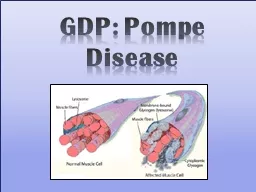PPT-GDP: Pompe Disease http://www.fightpompe.com/about/21/about-juan
Author : calandra-battersby | Published Date : 2018-11-06
What is Pompe Disease What does it look like httppompestoryblogspotcom200904joannescassianuspompe19011945html THREE TYPES but general model Symptoms Early onset
Presentation Embed Code
Download Presentation
Download Presentation The PPT/PDF document "GDP: Pompe Disease http://www.fightpompe..." is the property of its rightful owner. Permission is granted to download and print the materials on this website for personal, non-commercial use only, and to display it on your personal computer provided you do not modify the materials and that you retain all copyright notices contained in the materials. By downloading content from our website, you accept the terms of this agreement.
GDP: Pompe Disease http://www.fightpompe.com/about/21/about-juan: Transcript
Download Rules Of Document
"GDP: Pompe Disease http://www.fightpompe.com/about/21/about-juan"The content belongs to its owner. You may download and print it for personal use, without modification, and keep all copyright notices. By downloading, you agree to these terms.
Related Documents














